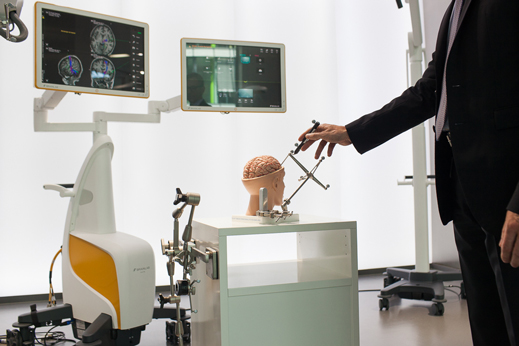Technology Jobs: Radiology
Radiology can date its birth to December 22, 1895, when the German physicist Wilhelm Röntgen shot electromagnetic radiation through his wife’s left hand to produce the world’s first human radiograph, a black-and-white image of a skeletal hand wearing a wedding ring.

In recent years, the transition from analog to digital imaging and advances in computer-based medical tools have allowed radiologists to access imaging results on a mobile phone or tablet and analyze them immediately. Now, new tools—designed to help radiologists deal with a rapidly growing amount of data and make faster, more accurate diagnoses—are changing the job in other unexpected ways.
Asked what a radiologist does, most people are likely to think of a physician sitting alone in a dark lab reading x-rays, says Moritz Wildgruber, a radiologist and researcher at the Klinikum Rechts der Isar hospital in Munich, Germany. At one time digital imaging technology seemed like a potential threat to the profession. Some feared that with “teleradiology,” radiographs could be efficiently sent off-site to be read assembly-line-style.
As with many technological shifts, the reality has been more tempered. In part because of strict regulations and liability issues limiting where a scan can be read and by whom, radiology has not been outsourced wholesale. On-site hospital radiology groups remain important, though teleradiology is used in remote areas and in overnight urgent care.
Technologies beyond digitization, however, have become increasingly important to radiology. Among them are computational medicine and data science.
New applications can reconstruct a tumor in 3-D and precisely measure its volume as it changes over time. “As a radiologist you cannot just stick to the images anymore; you have to be able to use this software,” says Wildgruber. “Otherwise you can’t deal with the workload.”

The increasing complexity of the work and the sheer volume of medical images, which now include video recordings and digital models, have created new challenges, and new opportunities, for companies like IBM and Germany’s Brainlab. “A typical emergency room radiologist will do 30 to 40 CT studies, with 2,000 to 3,000 images per study,” says Tanveer Syeda-Mahmood, chief scientist for a project at IBM that is developing automated radiology and cardiology tools. “You’re easily looking at 100,000 images per day.” With all this data—images for one patient might account for 250 gigabytes, says Syeda-Mahmood—a radiologist is at risk of missing the small percentage of images crucial to identifying pathologies.
IBM, which developed the Watson technology that triumphed on Jeopardy!, is testing whether similar computer–based reasoning, machine learning, and analytical problem solving modeled on human cognition could ameliorate some of these issues. According to the company, early work has demonstrated that the system can autonomously learn what a pathology looks like—say, an abnormal narrowing in a coronary artery—and automatically alert the radiologist to the most important images for a given patient.
The system is still learning, but Syeda-Mahmood says that in testing it has achieved over 80 percent accuracy with certain medical conditions—in the range of a good radiologist. Its education could be sped up by having it study the 30 billion images from hospitals, pharmaceutical companies, and clinical research organizations that the company recently acquired in its $1 billion purchase of Merge Healthcare.
Though Brainlab, whose major markets include North America, is working from a different angle, it too could greatly alter radiology by better utilizing imaging—both diagnostic and interventional—in the operating room.
A neurosurgeon working in an operating room outfitted with Brainlab’s image-guided surgery and intraoperative CT systems—like those at the Klinikum Grosshadern, in Munich—is able to visualize tools, anatomy, and radiologic images of diseases overlaid, in real time through a neurosurgeon’s scope, on the patient’s brain. At the same time, the radiologist can watch live feeds of the surgery in person or remotely, review images and video taken at various stages of the operation, and coördinate treatment.
These technological advances enable radiologists and other physicians to perform more kinds of treatments, including minimally invasive techniques like recanalization of blocked blood vessels and targeted tumor therapies carried out under image guidance.
This blurring of medical portfolios has begun to create conflicts between once-distinct medical specialties. “If you want to open an occluded artery with a stent,” says Wildgruber, “the radiologist can do it, the vascular surgeon can do it, the cardiologist can do it.” So whom do you go to when you arrive at the hospital for such a treatment? Today the answer, surprisingly, may come down to which department is available when you walk in.
Keep Reading
Most Popular
Large language models can do jaw-dropping things. But nobody knows exactly why.
And that's a problem. Figuring it out is one of the biggest scientific puzzles of our time and a crucial step towards controlling more powerful future models.
The problem with plug-in hybrids? Their drivers.
Plug-in hybrids are often sold as a transition to EVs, but new data from Europe shows we’re still underestimating the emissions they produce.
How scientists traced a mysterious covid case back to six toilets
When wastewater surveillance turns into a hunt for a single infected individual, the ethics get tricky.
Google DeepMind’s new generative model makes Super Mario–like games from scratch
Genie learns how to control games by watching hours and hours of video. It could help train next-gen robots too.
Stay connected
Get the latest updates from
MIT Technology Review
Discover special offers, top stories, upcoming events, and more.